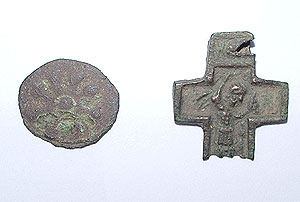People settled in Russia's Moscow Region long before Egyptians built pyramids
Instruments made of stone, solid flake-knife and two scrapers hinted at an earlier epoch when people settled on the territory

The other day, vandalism in the town of Korolev in Russia's Moscow Region was the reason of a sensational archeological discovery. The municipal administration organized a construction site on the territory where an ancient Slavic settlement was situated many centuries ago. When archeologists were finally allowed to the construction site for special examination, it turned out that people first settled there not in the Middle Ages as it had been supposed before but much earlier, in the mesolite epoch. In other words, the settlement in the Moscow Region appeared long before ancient Egyptians built their first pyramids! 
Senior research officer with Archeology Institute, Sergey Chernov, who was at the head of archeological wokrs conducted on the territory of the construction site, told the Moskovsky Komsomolets newspaper that specialists discovered four archeological beds. “A part of the finds belongs to the mesolite epoch (the 5th century B.C. which is two centuries before Egyptian pyramids appeared); some pertain to the early Iron Age (the 7-5th centuries B.C.). The other two layers are Old Russian ones,” the researcher said.
Instruments made of stone, solid flake-knife and two scrapers hinted at an earlier epoch when people settled on the territory. Such scrapers were used to cleanse inner surfaces of animal skins. People propagating the so-called Dyakovo culture got settled on the territory in the early Iron Age. The culture is called after the village of Dyakovo (now part of Moscow's preserve Kolomenskoye) where villagers propagated the same culture that the settlers on the territory of contemporary Korolev did. Archeologists arrived at the conclusion after they discovered a lot of textile ceramics. These items look as if they were wrapped in rough cloth after making them of clay.
Sergey Chernov adds it was in 2000 that archeologists found out the settlement existed on the territory in the 12-13th centuries. The excavations allowed to see that a rather prosperous settlement was situated there even in the 15th century.
A great number of various artifacts belonging to that epoch suggested archeologists that people living on the territory many centuries ago were rich. A unique cross belonging to the epoch of Basil II, the grandfather of Ivan the Terrible, and a coin minted under Ivan III are the most important discoveries made there. Researchers suppose that the cross was originally folding. Saint Nikita, “the persecutor of demons” is depicted on it beating a demon.
The recent archeological discoveries allow researchers to say that the discovered settlement used to be the center of a political subdivision of the Moscow principality, the Bokhov camp. Historians have not yet defined its exact location. Ancient documents tell us about many patrimonial estates on the territory of the camp. They belonged to landlords and thus carried out no administrative duties.
Subscribe to Pravda.Ru Telegram channel, Facebook, RSS!


